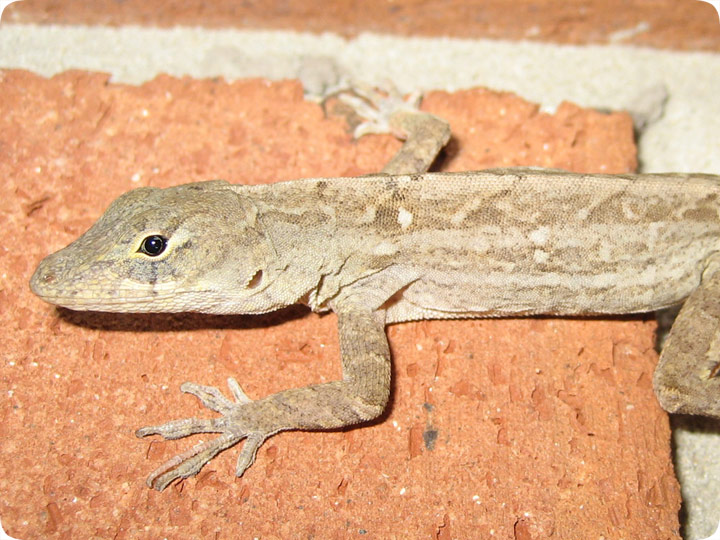-
info@aaanimalcontrol.com
Call us for help in your town
Humane Wildlife Education
Green Anole

11.28.2006 - The Green Anole, (Anolis carolinensis) is also called the Carolina Anole. It lives in the southeast US and throughout Florida. This small lizard can grow to about eight inches. Males are larger than females and have a throat fan, or dewlap. This lizard
can change color to match its background, and they eyes can move independently, like a chameleon. They eat a variety of small prey, mostly insects. If attacked, they can detach their tail in hopes that a predator will go for that as opposed to the more
vital parts. They can live up to seven years in captivity, but probably don't live more than three years in the wild.
This lizard is popular as a pet. They are easy to keep and care for. My little sister had one for a few years. She named it
Sticky, because it could stick to any surface. It's true. They have excellent gripping capability, and can run right up walls and almost any surface. Eventually Sticky found himself stuck on the bottom of a shoe, and that was the end of him.
These things are everywhere in Florida. They are just about the most common vertebrate. I've played a game in which I step outside my door with eyes closed, and then I open them and count the number of seconds it takes before I spot one. It's usually about two.
I also see how many I can spot within my single field of vision at any given time, and the record is eight. They are often quite skittish, however, and aren't the easiest to grab or photograph. However, this older one stayed still long enough for me to get up close
and take a high-detailed photo. It's in a boring tan phase, but they can be bright green, or almost black, smooth, checkered, etc.
Do it yourself: Visit my How To Get Rid of Lizards page for tips and advice.
Get professional help: Visit my Nationwide Pro Directory of wildlife removal experts.
For more wildlife stories, click my Wildlife Blog
or click my below banner to hire a local trapper.
The green anole (Anolis carolinensis) is either green or brown depending upon local environmental conditions. Although not a real chameleon, anoles are closely related to chameleons. An adult green anole's length is generally between 5-8 inches (12-20 cm). Green anoles are found in the southeastern United States, especially congregating in Georgia and South Carolina. Anoles are found in almost all habitats in these areas including urban, forest, and even (rarely) beach areas. The only habitat anoles consistently avoid are mountain areas because they can't withstand high elevation. Green anoles can live up to seven years in captivity and up to five years if they live in an agreeable habitat.
Reproduction
Green anoles are polygynous meaning that male green anoles will have multiple partners throughout their life while females only mate with one male throughout their life. Female green anoles will lay a single egg during warm months between April and August. Females will make a nest in moist soil or rotten wood, they're looking for something that gives off a bit of heat.
To attract the attention of female green anoles, males will move their heads up and down and extend their dewlaps. The female will then decide whether or not the male's dance appeased her. If it did, the mating will begin. Although males have multiple partners, they will protect their mate from invasive males and other predators. Once the baby green anole has been hatched, the mother will leave and the baby will be on its own.
Are Green Anoles Dangerous? Are They an Invasive Species?
The green anole is not harmful to humans or pets at all. In fact, green anoles are a blessing to have in your garden because they'll eat pests like cockroaches, flies, and grubs. Anoles do not chew their prey, they simply chomp and swallow it whole.
Green anoles are not an invasive species but brown anoles are. Just because a green anole is brown does not mean that it is a brown anole! Green anoles' colors change depending on their habitat. Brown anoles came from Cuba in the 1950s and landed primarily in Florida. With the same food source and habitats, it's very hard to distinguish the two. In response to the brown anole invasion, green anoles have been evolving their toepads (for climbing trees) at an unprecedented rate. Green anoles have been finding higher and higher branches to find insects on. This could enable the native green anoles to outlive the invasive brown anole because they're higher up meaning they'll have first dibs on an insect. On the other hand, anoles' main predators are birds. Because the green anoles are higher up and closer to a bird scouting for food, they're more likely to become a bird's prey. Not to worry though, neither species is going extinct any time soon because there's not a ton of competition for food right now.




















